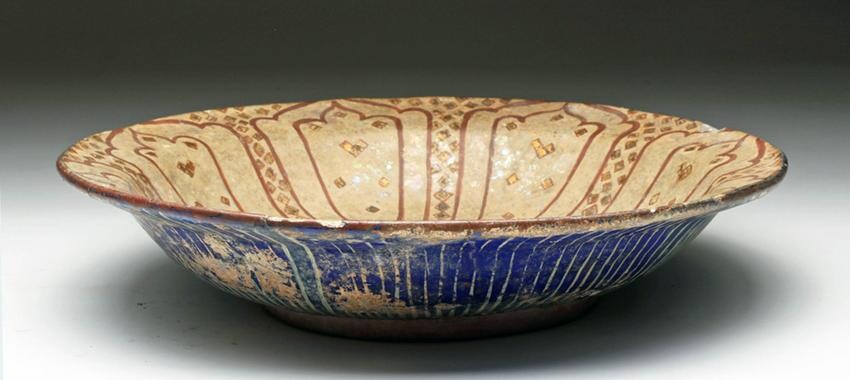12th C. Kashan Luster Glazed Bowl - Blue Underside
**Originally Listed At $3000**
Central Iran, ca. late 12th / early 13th centuries CE. Of rounded form on short foot, the interior is painted with an overall foliate or star-like composition with a central eight-pointed star, in copper hued pigments that were most likely covered with glazes whose contents have become iridescent. The underside of the bowl is covered with striking cobalt blue overlaid with silver hued striations. Clear glaze, sometimes tinted with cobalt, was sometimes used for the exterior surfaces of bowls. Once the glaze was fired and decorated with the luster compound a second firing at a lower temperature with restricted airflow removed the oxygen from the metal oxide, fixing a layer of metal only a few molecules thick with a lustrous sheen upon the surface of the vessel or tile. The temperature and duration of the second firing had to be very precisely controlled, and, when taken alongside the volatility of metal oxides in the kiln, it oftentimes did not result in the most pristine finish. The technical knowledge required was quite complex. Size: 13-3/8"; in diameter x 2-3/4";.
Islamic proscription forbade the use of precious metals such as gold and silver for the making of vessels. This conversely opened up another market to the potter, as gold and silver lustered ceramic vessels did not fall under this ban. The range of color available with luster is from ruby red, to shades of brown, to chartreuse, and lemon. Luster was used on plates, bowls, ewers, and tile, and is a decorative technique that is purely of Middle Eastern origin, and not Chinese.
The town of Kashan, was a city associated with high-quality ceramic production in the medieval period. It appears to have been a major site for the manufacture of fine wares between the 1170s and 1220s as well as in the later 13th and early 14th centuries. Kashan lusterware is superior in quality to all others and often features dense patterns and every square inch of surface area is decorated.
Provenance: ex-Sarkisian Gallery, Denver, Colorado, USA, Before 2010
All items legal to buy/sell under U.S. Statute covering cultural patrimony Code 2600, CHAPTER 14, and are guaranteed to be as described or your money back.
A Certificate of Authenticity will accompany all winning bids.
PLEASE NOTE: Due to recent increases of shipments being seized by Australian & German customs (even for items with pre-UNESCO provenance), we will no longer ship most antiquities and ancient Chinese art to Australia & Germany. For categories of items that are acceptable to ship to Australia or Germany, please contact us directly or work with your local customs brokerage firm.
#108323
Condition Report: Repairs to rim and body. Surface wear with abrasions and losses to glaze as shown.
View it on
Estimate
Time, Location
Auction House
**Originally Listed At $3000**
Central Iran, ca. late 12th / early 13th centuries CE. Of rounded form on short foot, the interior is painted with an overall foliate or star-like composition with a central eight-pointed star, in copper hued pigments that were most likely covered with glazes whose contents have become iridescent. The underside of the bowl is covered with striking cobalt blue overlaid with silver hued striations. Clear glaze, sometimes tinted with cobalt, was sometimes used for the exterior surfaces of bowls. Once the glaze was fired and decorated with the luster compound a second firing at a lower temperature with restricted airflow removed the oxygen from the metal oxide, fixing a layer of metal only a few molecules thick with a lustrous sheen upon the surface of the vessel or tile. The temperature and duration of the second firing had to be very precisely controlled, and, when taken alongside the volatility of metal oxides in the kiln, it oftentimes did not result in the most pristine finish. The technical knowledge required was quite complex. Size: 13-3/8"; in diameter x 2-3/4";.
Islamic proscription forbade the use of precious metals such as gold and silver for the making of vessels. This conversely opened up another market to the potter, as gold and silver lustered ceramic vessels did not fall under this ban. The range of color available with luster is from ruby red, to shades of brown, to chartreuse, and lemon. Luster was used on plates, bowls, ewers, and tile, and is a decorative technique that is purely of Middle Eastern origin, and not Chinese.
The town of Kashan, was a city associated with high-quality ceramic production in the medieval period. It appears to have been a major site for the manufacture of fine wares between the 1170s and 1220s as well as in the later 13th and early 14th centuries. Kashan lusterware is superior in quality to all others and often features dense patterns and every square inch of surface area is decorated.
Provenance: ex-Sarkisian Gallery, Denver, Colorado, USA, Before 2010
All items legal to buy/sell under U.S. Statute covering cultural patrimony Code 2600, CHAPTER 14, and are guaranteed to be as described or your money back.
A Certificate of Authenticity will accompany all winning bids.
PLEASE NOTE: Due to recent increases of shipments being seized by Australian & German customs (even for items with pre-UNESCO provenance), we will no longer ship most antiquities and ancient Chinese art to Australia & Germany. For categories of items that are acceptable to ship to Australia or Germany, please contact us directly or work with your local customs brokerage firm.
#108323
Condition Report: Repairs to rim and body. Surface wear with abrasions and losses to glaze as shown.



